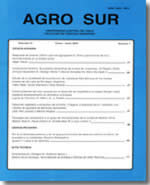Pesticide application windows for kiwi (Actinidia deliciosa) orchards in the Linares area
Main Article Content
Abstract
The objectives of this work were to establish efficacious and non-polluting pesticide application windows for kiwi orchards located in the Linares area, VII Region of Chile; to compare these with the time demands of the spraying schedule and with the effective work capacity of the turbo sprayers available in the market and the area of the orchards. In order to achieve these objectives a 25-year (1976-2000) meteorological data base was processed. The data included daily rainfall, wind speed, maximum temperature and relative humidity.
The results showed that, in general, there is sufficient appropriate time available to carry out these applications (Mean=19.0 days/month; Range=15.5–22.8 days/month; S=5.96 days/month), even at high probability levels. The months with the larger number of appropriate days are March and April; this time decreases greatly in January and February due to high temperatures and wind speed (pollution), and in the months of June and July due to high rainfall (not efficacious). The comparison of the spraying program with the magnitude of the windows shows an adequate relationship between them. Given the amplitude of the windows and the work capacity of the existing sprayers, the pesticide applications can be carried out in a timely fashion during the corresponding period.
It is possible to program pesticide applications in kiwi orchards of the Linares area in an efficacious and non-polluting manner.

